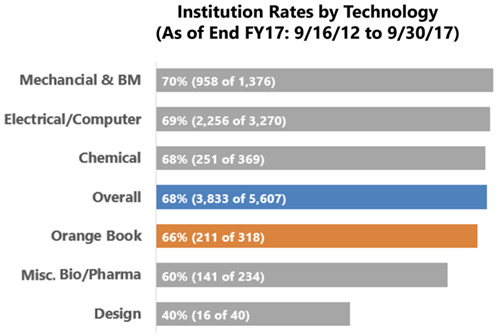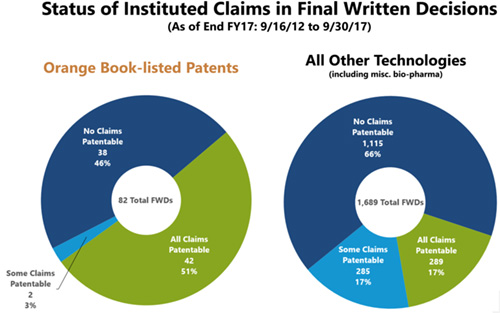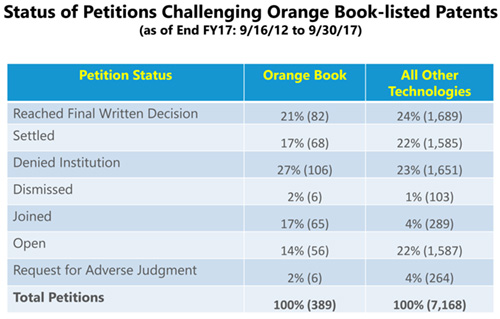
Three Statistics Every ANDA Filer Needs To Know About Orange Book Patent Trials At the USPTO
On March 13, 2018 the United States Patent and Trademark Office (USPTO) released the results of its study on inter partes review (IPR) and post-grant review (PGR) proceedings involving Orange Book patents. The study included the results of all 389 petitions challenging Orange Book patents filed during the first five years of these proceedings. Here are the top three statistics from the study that every ANDA filer needs to know:
(1) The institution rate for petitions on Orange Book patents is 66%, which is
about the same as the overall institution rate across all technologies of 68%.
(2) The rate at which the USPTO holds all challenged claims unpatentable for
Orange Book patents is 46%, which is significantly lower than the rate across
all other technologies of 66%.
(3) When settlement is considered as a favorable outcome for an IPR petitioner,
then 43% of petitions on Orange Book patents reached a result that typically
favors the petitioner, as calculated by combining (a) the number of
settlements, (b) the number of final written decisions holding at least one
claim unpatentable, and (c) the number of requests for adverse judgment.
The significance of each of these three statistics is discussed in more detail below.
(1) The institution rate for petitions on Orange Book patents is 66%, which is about the same
as the overall institution rate across all technologies of 68%.
The USPTO trial institution rate for petitions challenging Orange Book patents versus all other technology areas is shown below.1
ANDA filers should be aware that the USPTO has denied institution of trial for 33% of Orange Book petitions. Therefore, parties seeking to challenge an Orange Book patent at the USPTO should carefully evaluate the relative strength of their prior art and allocate appropriate resources to thoroughly explain their invalidity positions in order to maximize the likelihood of institution.
(2) The rate at which the USPTO holds all challenged claims unpatentable for Orange Book
patents is 46%, which is significantly lower than the rate across all other technologies of
66%.
The results of USPTO final written decisions on Orange Book patents versus all other technology areas are shown below.

Final written decisions on Orange Book patents held all challenged claims unpatentable on 38 out of 82 petitions (i.e., 46%). This rate is significantly lower than the rate of 66% for all other technology areas. Final written decisions on Orange Book patents upheld patentability of all challenged claims on 42 out of 82 petitions (i.e., 51%). Thus, final written decisions on Orange Book patents have favored the patent owner more often than the petitioner.
In addition, the USPTO’s final decisions on Orange Book patents tend to be binary: either all challenged claims were held unpatentable (38 times) or all challenged claims were upheld (42 times). There were only two final written decisions on Orange Book patents (3%) that reached a mixed result with some claims being upheld and other claims being canceled. In contrast, 17% of final written decisions in other technology areas reached a mixed result.
Orange Book petitions reached a final decision holding at least one claim unpatentable only 49% of the time (i.e., 46% all claims unpatentable + 3% some claims patentable), whereas final decisions in all other technology areas held at least one claim unpatentable 83% of the time (i.e., 66% of all claims unpatentable + 17% some claims patentable). These results indicate that it is more difficult to reach a final written decision holding claims unpatentable for Orange Book patents than other technology areas. These results emphasize that parties seeking to challenge an Orange Book patent at the USPTO should put forth their strongest possible petition to maximize their likelihood of success.
(3) Combining settlements, final written decisions holding at least one claim unpatentable,
and requests for adverse judgment, shows that 43% of petitions on Orange Book
patents reached a result that typically favors the petitioner.
The status of petitions challenging Orange Book patents is shown below. 
Out of the 389 total Orange Book patent petitions, there have been 268 petitions that have been resolved by final written decision (82), settlement (68), denial of institution (106), dismissal (6), or request for adverse judgement (6). Out of these 268 resolved petitions, there were 114 (i.e., 43%) outcomes that typically favor the petitioner. Specifically, there were:
• 40 petitions that held at least one claim unpatentable,
• 6 requests for adverse judgment, and
• 68 petitions terminated due to settlement.
Of the 68 settlements, 38 occurred before the institution decision, and 30 occurred after institution.
The 43% success rate indicates that USPTO trials have provided a relatively effective tool for ANDA filers, however, the final written decision success rate for petitioners of Orange Book patents is significantly lower than other technology areas.
Deciding whether an IPR or PGR should be pursued in connection with launching any particular ANDA product is complicated and involves many considerations, such as whether you have first-filer or second-filer status, the number of co-defendants likely to be involved in corresponding district court litigation, and the relative strength of the asserted prior art. The attorneys at Knobbe Martens have extensive experience counseling ANDA filers about the latest trends in USPTO trials and ANDA litigation strategies. Please contact us to help you develop the best approach for successfully launching your next ANDA product.
1 All charts and figures in this article were reproduced from the USPTO’s study, which is available to the public at the following website: https://www.uspto.gov/sites/default/files/documents/chat_with_the_chief_march_2018.pdf

